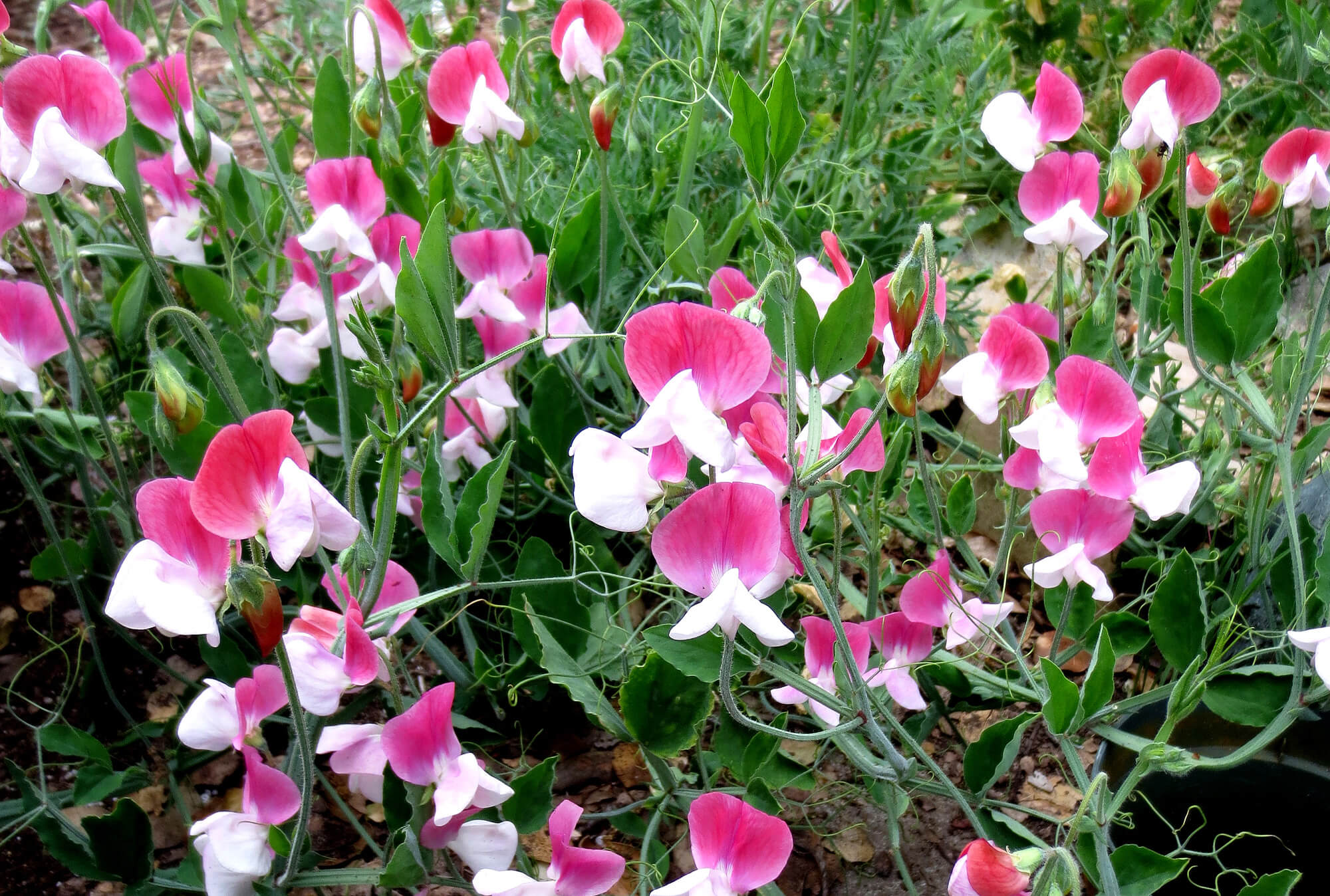Fall is the best time to plant peas. If you plant pea seeds or seedlings in October/November, the plant tops will continue to grow until day length shortens and temperatures drop. Then, with water from rain (hopefully) or your hose, the roots will continue to grow unseen. When the days lengthen and warm up, you’ll see a burst of top growth that’s supported by those established roots. Usually you’ll have flowers in January and ripe pods in February.
The other reason to start peas in the fall is the Bay Area’s spring mildew scourge. If you start harvesting your peas in early spring, you will have had a decent crop by the time mildew takes over your plants. If you plant in February/March, you will just be starting your harvests when the coastal summer fog appears and creates the optimal conditions for mildew.
All of the above information applies to ornamental sweet peas, only the harvest will be bunches of colorful, fragrant flowers.
Planting and growing peas
 While the soil temperature is still over 60°F you can plant pea seeds directly in the garden. If you have slugs and snails in your garden, you might prefer to buy seedlings that are less tender and vulnerable to these creature’s soft yet capable mouthparts. If birds bother your seedlings, hang some bird netting over bamboo stakes to deter them until the plants grow larger and less tender.
While the soil temperature is still over 60°F you can plant pea seeds directly in the garden. If you have slugs and snails in your garden, you might prefer to buy seedlings that are less tender and vulnerable to these creature’s soft yet capable mouthparts. If birds bother your seedlings, hang some bird netting over bamboo stakes to deter them until the plants grow larger and less tender.
To support pole varieties, make a triangular tower of 3 poles. Push the ends firmly into the ground and tie the tops together. Wind some cotton string around the poles in rows about 6” apart for the pea tendrils to grasp as they climb. Use cotton so at the end of the season you can cut both string and dead vegetation and compost it all.
Bush peas grow only 2 to 4’ tall. Using something to support them a bit can keep heavy rain from flattening them and make harvesting easier but isn’t mandatory.
Separating shelling, snap and snow pea varieties will make it easier to tell when each is ready to harvest. And, the more you pick, the larger your harvest will be.
Ornamental sweet peas need support as well although you can be more creative with your trellising strategies. Grow up through an existing deciduous shrub, let clamber through your roses or create a sculptural grid with yard prunings. The more bouquets you pick, the longer you’ll be able to.
Here are some of our favorite varieties available in the seed racks. Check the bedding plant section for seedlings.
Edible varieties
SUGAR SNAP ~ This sweet pole edible pod pea is harvested when the peas swell to fill the pod. Great to eat right off the vine and popular with children. Vigorous 5 to 6’ vine. Botanical Interests Seed Co.
OREGON GIANT ~ This large pod bush snow pea is easy to grow. Pods are 5” long, sweet and crisp. Wonderful in salads and stir-fries. Plants are 3’ high. Renee’s Garden Seeds
GREEN ARROW ~ A bush shelling variety that sets slim pods. Inside are deep green peas that are equally good raw as lightly cooked. 2 to 3’ vine. Botanical Interests Seed Co.
Ornamental varieties
PAINTED LADY ~ This fragrant, bi-color heirloom pole variety was introduced in 1737. Just a couple of the small white and deep rose flowers fill a room with their wonderful scent. Renee’s Garden Seeds
APRIL IN PARIS ~ Cream-colored blossoms are tinted with bands of purple on the edges that widen with age. Robust 6’ vines produce long stems, large flowers and a strong fragrance. Renee’s Garden Seeds


